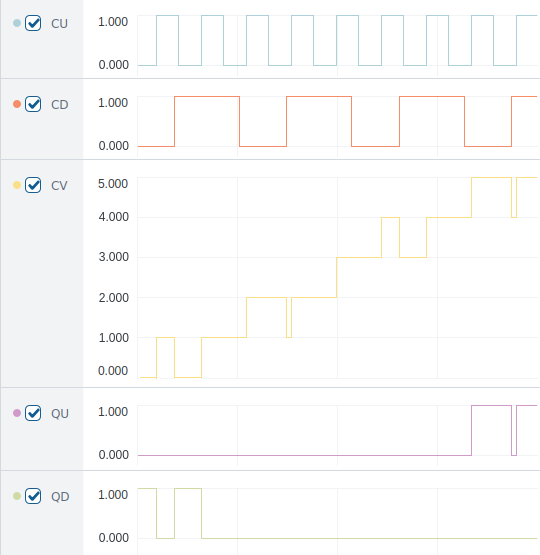CTUDOperator Class
(Automation::CTUDOperator)The CTUDOperator is a rising edge counter operator, or CTUD counter as referenced by IEC 61131-3 in PLC. More...
| Header: | #include <CTUDOperator> |
| Inherits: | CDPOperator<T> |
Public Functions
| CTUDOperator(const CDPPropertyBase &in, const std::string &outputType) |
Reimplemented Public Functions
- 18 public functions inherited from CDPOperator
- 18 public functions inherited from CDPOperatorBase
- 50 public functions inherited from CDPBaseObject
- 27 public functions inherited from CDP::StudioAPI::CDPNode
- 22 public functions inherited from CDP::StudioAPI::ICDPNode
Additional Inherited Members
- 1 public variable inherited from CDPOperatorBase
- 1 static public member inherited from CDPBaseObject
- 1 protected function inherited from CDP::StudioAPI::CDPNode
- 8 protected variables inherited from CDPOperator
- 5 protected variables inherited from CDPOperatorBase
- 10 protected variables inherited from CDPBaseObject
Detailed Description
The CTUDOperator is a rising edge counter operator, or CTUD counter as referenced by IEC 61131-3 in PLC.
The CTUDOperator is increasing the count value (CV) on rising edge in the count up input (CU) and decreasing the count value on rising edge in the count down input (CD). The count up output (QU) is set to true when the count value has reached the preset value (PV). The Count down output (QD) is set to true when the count value has reached to zero.
Arguments
| Name | Description |
|---|---|
| CU | Count up enable (rising edges of this value will be up counted) |
| CD | Count down enable (rising edges of this value will be down counted) |
| PV | Preset value (counter limit) |
| CV | Count value (current number of rising edges left to be counted) |
| QU | Will be set to true when count value has reached preset value |
| QD | Will be set to true when count value has reached to zero |
| R | Reset counter (set count value to zero) |
| LD | Load counter (set count value to preset value) |
When operator is used inside a signal its default input is automatically tied to signal's InternalValue or previous operator's output. Its default output is automatically tied to next operator's input or to signal's Value. See also CDP Operator Usage In CDP Signals.
Example
Below are the example plots for CTUDOperator(PV=5) up input (CU, cyan), down input (CD, orange), count value (CV, yellow), up reached output (QU, magenta) and down reached output (QD, green).

Actual Processing Code of the CTUDOperator
unsigned int CTUDOperator<T>::Process() { if (!m_CD || !m_PV || !m_R || !m_LD || !m_QU || !m_QD) return STATUS_ERROR; if ((bool)*m_R) { *m_CV = 0; *m_R = false; } if ((bool)*m_LD) { *m_CV = m_PV->ValueProperty(); *m_LD = false; } bool CU = (bool)*m_CU; if (CU && m_oldCU != CU && (*m_CV < *m_PV)) *m_CV = *m_CV + 1; bool CD = (bool)*m_CD; if (CD && m_oldCD != CD && (*m_CV > 0)) *m_CV = *m_CV - 1; *m_QU = (*m_CV >= *m_PV); *m_QD = (*m_CV == 0); m_oldCU = CU; m_oldCD = CD; return STATUS_OK; }
See also Argument.
Member Function Documentation
CTUDOperator::CTUDOperator(const CDPPropertyBase &in, const std::string &outputType)
Default constructs an instance of CTUDOperator.
[override virtual] void CTUDOperator::Configure(XMLPrimitive *operatorXML)
[override virtual] unsigned int CTUDOperator::Process()
Get started with CDP Studio today
Let us help you take your great ideas and turn them into the products your customer will love.